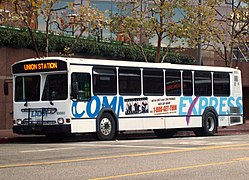
A school bus is any type of bus owned, leased, contracted to, or operated by a school or school district. It is regularly used to transport students to and from school or school-related activities, but not including a charter bus or transit bus. Various configurations of school buses are used worldwide; the most iconic examples are the yellow school buses of the United States which are also found in other parts of the world.

Van Hool NV is a Belgian family-owned coachbuilder and manufacturer of buses, coaches, trolleybuses, and trailers.

The Crown Coach Corporation is a defunct American bus manufacturer. Founded in 1904, the company was best known for its Supercoach range of yellow school buses and motorcoaches; the former vehicles were marketed throughout the West Coast of the United States. Competing alongside Gillig Corporation and similar its Gillig Transit Coach, the two companies supplied California with school buses nearly exclusively into the 1980s.

Gillig is an American designer and manufacturer of buses. The company headquarters, along with its manufacturing operations, is located in Livermore, California. By volume, Gillig is the second-largest transit bus manufacturer in North America. As of 2013, Gillig had an approximate 31 percent market share of the combined United States and Canadian heavy-duty transit bus manufacturing industry, based on the number of equivalent unit deliveries.
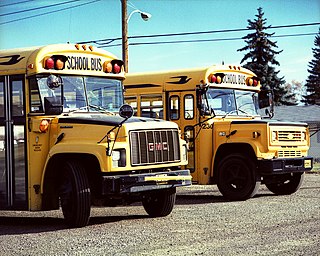
The Chevrolet and GMC B series was a series of cowled chassis that were produced by General Motors. Produced across three generations from 1966 to 2003, the model line was a variant of medium-duty trucks marketed under the Chevrolet and GMC nameplates. Initially derived from the medium-duty C/K series, later examples were derived from the GMT530 architecture.

The GM New Look bus is a municipal transit bus that was introduced in 1959 by the Truck and Coach Division of General Motors to replace the company's previous coach, retroactively known as the GM "old-look" transit bus.

The Rapid Transit Series (RTS) city bus is a long-running series of transit buses that was originally manufactured by GMC Truck and Coach Division during 1977, in Pontiac, Michigan. First produced in 1977, the RTS was GMC's offering of an Advanced Design Bus design (the other entry was the Grumman 870 by competitor Flxible) and is the descendant of GMC's prototype for the U.S. Department of Transportation's Transbus project. The RTS is notable for its then-futuristic styling featuring automobile-like curved body and window panels; the Advanced Design Buses were meant to be an interim solution between the high-floor transit buses that preceded them, such as the GMC New Look (which had a curved windshield, but flat side glass and body panels), and modern low-floor buses that would facilitate passenger boarding and accessibility. Most current buses are now made by specialized coach manufacturers with flat sides and windows.

The GM "old-look" transit bus was a transit bus that was introduced in 1940 by Yellow Coach beginning with the production of the model TG-3201 bus. Yellow Coach was an early bus builder that was partially owned by General Motors (GM) before being purchased outright in 1943 and folded into the GM Truck Division to form the GM Truck & Coach Division. The Yellow Coach badge gave way to the GM nameplate in 1944. Production of most "old-look" models was stopped upon the release of the GM New-Look bus in 1959, however some smaller "old-look" models continued to be built until 1969. Approximately 38,000 "old-look" buses were built during the 29-year production run. The "old-look" name is an unofficial retronym applied to this series of GM buses after the release of the GM New-Look series.

The Thomas Saf-T-Liner is the name of the transit-style school bus product line produced by Thomas Built Buses. Introduced in 1978, the Saf-T-Liner marked the transition to in-house chassis production by Thomas. In addition to school bus applications, variations of the Saf-T-Liner have been produced as activity buses, specialty vehicles, and commercial/transit buses. It can also be used to describe the Saf-T-Liner C2 or Saf-T-Liner FS-65, but they are not considered part of the Saf-T-Liner family.
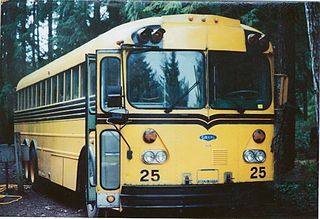
The Gillig Transit Coach School Bus is a series of buses that were produced by the American bus manufacturer Gillig from 1940 to 1982. Alongside its namesake usage as a yellow school bus, the Transit Coach also served as the basis of motorcoaches and other commercial-use vehicles. Marketed primarily to operators on or near the West Coast of the United States, the Transit Coach competed nearly exclusively against the similar Crown Supercoach through much of its production.
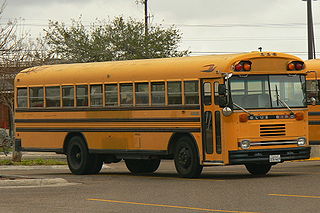
The Blue Bird TC/2000 is a product line of buses that was produced by the American manufacturer Blue Bird Corporation from 1987 to 2003. Introduced as a second transit-style product range alongside the Blue Bird All American, the TC/2000 was produced in front-engine and rear-engine layouts. While produced primarily as a yellow school bus, Blue Bird offered the TC/2000 in commercial configurations and numerous custom-built variants. For commercial use, Blue Bird badged the model line as the TC/2000 or the APC 2000.

The Blue Bird All American is a series of buses produced by American school bus manufacturer Blue Bird Corporation since 1948. Originally developed as a yellow school bus, versions of the All American have been designed for a wide variety of applications, ranging from the Blue Bird Wanderlodge luxury motorhome to buses for law enforcement use.

The ThomasMinotour is a bus body manufactured by Thomas Built Buses since 1980. The smallest vehicle sold by the company, the Minotour is a bus body designed for cutaway van chassis. Primarily sold for school bus usage, the Minotour is also produced as a MFSAB or in specialized configurations specified by the customer.
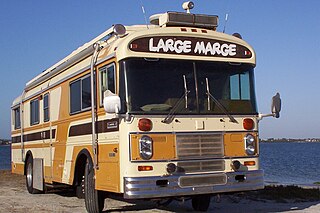
Wanderlodge is a retired series of recreational vehicles built by American bus manufacturer Blue Bird Body Company. Introduced as the Blue Bird Transit Home in 1963, the Wanderlodge was a derivative of the Blue Bird All American school bus for over year; two further generations were produced, adapting motorcoach body and chassis design.
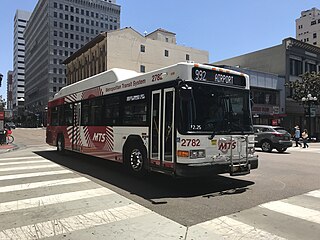
The Gillig Low Floor is a transit bus manufactured by Gillig since 1997. The second low-floor bus design introduced in the United States, the Low Floor originally served as a second product range for the company alongside the Gillig Phantom. As transit bus operators shifted toward low-floor designs, the Low Floor has replaced the Phantom entirely, becoming the sole vehicle platform offered by the company since 2008.

The Crown Supercoach is a bus that was constructed and marketed by Crown Coach Corporation from 1948 to 1991. While most examples were sold as yellow school buses, the Supercoach formed the basis for motorcoaches and other specialty vehicles using the same body and chassis. While technically available outside of the West Coast, nearly all Crown school buses were sold in Washington state, Oregon and California.
The Wayne Lifestar is a product line of buses that was manufactured and marketed by Wayne Corporation and its successor company Wayne Wheeled Vehicles from 1986 to 1995. Produced nearly exclusively in a school bus configuration, the Wayne Lifestar used a transit-style body configuration with a front-engine chassis. Marking the return to transit-style production, the Lifestar adopted the single-piece body stampings of the Wayne Lifeguard in its construction.
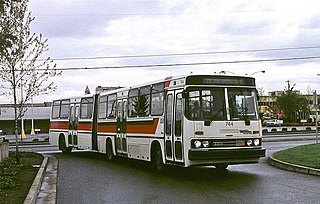
The Crown-Ikarus 286 is a type of transit bus that was manufactured for the U.S. market from 1980 until 1986, under a joint venture between the Ikarus Body and Coach Works (Ikarus), of Budapest, Hungary, and Crown Coach Corporation from Los Angeles, California in the United States. Loosely based on the Ikarus 280, the Crown-Ikarus 286 is a high-floor articulated bus.

The Low Floor Series (LFS) is a series of transit buses manufactured by Nova Bus for North American customers from 1996 to the present. It is produced in 40' rigid and 62' articulated (nominal) lengths with a variety of powertrains, including conventionally-fueled, hybrid diesel-electric, and battery-electric. The LFS is the first transit bus designed by Nova Bus.

The Flyer 700/800/900 series were a series of transit buses built in three generations by Western Flyer and its successors Flyer Industries and New Flyer, of Canada, between 1967 and 1987. Except for brief overlap during transition from one generation to the next, they were not in production concurrently. All individual model designations included a prefix of either D, for diesel propulsion, or E, for electrically powered trolleybuses, with the first digit indicating the generation and the last digit indicating a variant within the generation. The introductory model was the D700, originally released in 1967 for the Canadian transit market, and the last series group to be produced, D900, was discontinued in 1987. Flyer had become New Flyer only the year before, in 1986.

